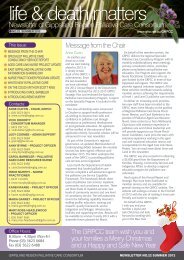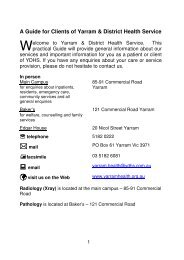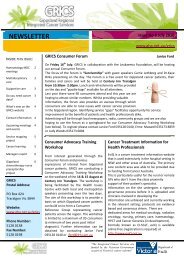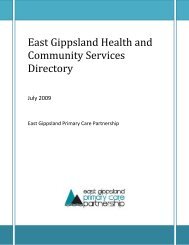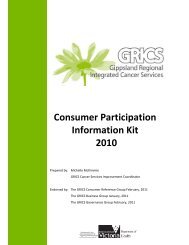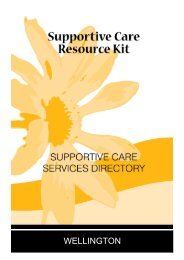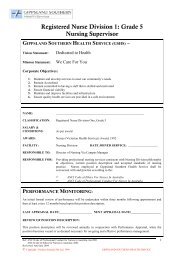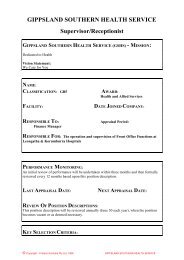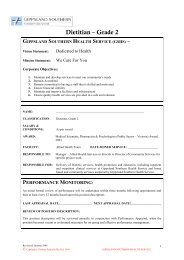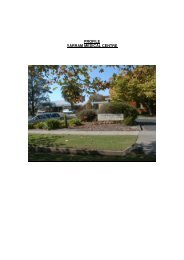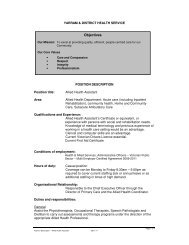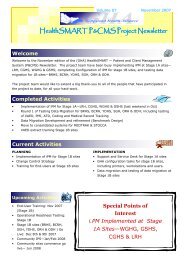You also want an ePaper? Increase the reach of your titles
YUMPU automatically turns print PDFs into web optimized ePapers that Google loves.
<strong>50</strong><br />
<strong>Remembering</strong> back<br />
Following is a collection of memories from former staff members, doctors and board members about<br />
their time at the Woorayl District Memorial hospital:<br />
“Quite a few public meetings were called (in the early 19<strong>50</strong>s to decide on which site to build the hospital),<br />
the final one chaired by the Shire President at that time, Councilor Arthur Ashendon. As a result of this, a<br />
new committee was formed and this committee, with myself as chairman, was given the job of building<br />
the ‘Woorayl District Memorial Hospital’ on the new site. We were also responsible for running the<br />
existing hospital until the new one was erected and commissioned.<br />
By 19<strong>50</strong> we were very busy with fundraising, (particularly through the “Top Town Competition,”) running<br />
the Bush Nursing Hospital and fencing and planting trees on the new site. We were also talking to<br />
Leighton and Irwin about new plans to be approved by the Hospital and Charities Commission.<br />
At this time unfortunately my health broke down and I spent several months in St Vincent’s Hospital,<br />
Melbourne. I was 34 years old with three young children and the youngest member of the committee.<br />
<strong>The</strong> committee carried on with Councilor Richards from Dumbalk as Chairman and George Sims was<br />
secretary. <strong>The</strong> new hospital, <strong>The</strong> Woorayl District Memorial Hospital was finally opened in 1958. <strong>The</strong> Life<br />
Governor’s certificate which was presented to me, was signed by Peter O’Malley, President and George<br />
Sims, Secretary.<br />
I am now 92 years old and have been gone from Leongatha since 1953 but it will always be my home<br />
wherever I may be or have been.<br />
God bless the administration and staff of the Woorayl District Memorial Hospital, built in memory of all<br />
who took part in the second World War 1939-1945.”<br />
Mr Greg Welsford<br />
(former board member)<br />
March 2008<br />
“When the hospital opened, it was all so new, and we<br />
didn’t have any patients until they were gradually<br />
transferred by ambulance. By the end of the first day<br />
there was about 3 or 4 patients. May Workman<br />
worked night duty. <strong>The</strong> mother of the first baby born<br />
at the new hospital was presented with a pram.”<br />
“I remember making the beds with brand new<br />
“Physician” pure wool blankets - then a sheet was put<br />
over the blanket, so that when the quilts were taken<br />
off at night, the blanket would be protected.”<br />
“I have wonderful memories of the opening of the<br />
hospital eg my parents were in the Horticultural<br />
Society that planted all the trees and shrubs.”<br />
Dorothy Potter<br />
(former nurse)<br />
May 2008<br />
“Wonderful memories of working there, lots of<br />
fun, wonderful people to work with. I worked at<br />
the old hospital which is now Woorayl Lodge.<br />
Everyone had input into the plans for the new<br />
hospital. When the new hospital opened I can<br />
remember putting covers on all the new<br />
mattresses. Once the Jean MacRae Wing opened<br />
I was in charge there for about 10 years - enjoyed<br />
every minute of it as well, however left before<br />
Koorooman House was built. Uniforms back then<br />
were white, and if they got a mark on them we<br />
had to change them.”<br />
Janet Mansfield<br />
(former nurse)<br />
May 2008<br />
* Mrs Mansfield’s daughter worked at the hospital, followed by her granddaughter<br />
who is still currently working there.
51<br />
“In the 1960s the hospital acquired a pathologist. He would perform pregnancy tests by injecting male<br />
European toads (Bufo viridis) with the woman’s urine. A positive test was when sperm appeared in the toad’s<br />
urine. One night the toads escaped and were eventually found in the labour ward.<br />
Dr Alec Bennett did post mortems at the Leongatha Hospital when they were required by the coroner<br />
because this was cheaper than transporting the bodies to Melbourne. <strong>The</strong> hospital had a very substandard<br />
shed for doing these. Alec recalls doing a post mortem on a hot day with the legally-required policeman in<br />
attendance. <strong>The</strong> stench and blow-flies were too much for the policeman who started vomiting and had to lie<br />
down on the grass outside. Later post mortems were done in better facilities at Korumburra.<br />
Because of the distance from Melbourne, the doctors sometimes had to do emergency surgery for which<br />
they were not trained. On one occasion a young man with a serious head injury needed holes drilled into his<br />
head to relieve pressure. Dr Bennett drilled the holes while Dr Eagger read to him from a book on what to do.<br />
During the 1960s care of premature babies was primitive and if premature babies were born at Leongatha,<br />
the doctors were advised to do the best they could caring for them, because they wouldn’t receive better<br />
care in Melbourne. On one occasion Dr Eagger was trying to care for a baby born 10 weeks prematurely at<br />
Leongatha. He came up with the innovation of a safety pin through the baby’s chest connected to a string to<br />
provide an upward splint. <strong>The</strong> baby survived.<br />
On one occasion a patient was being cared for at the hospital during December while she recovered from a<br />
stroke. Her husband was very grateful for the care she was receiving and brought to the hospital several live<br />
white geese as presents for the staff for their Christmas dinners. When he brought them to the hospital they<br />
were stored in the mortuary, and forgotten about. A few nights later the night nurses had to take out to the<br />
mortuary, a deceased patient. This was a scary experience for the junior staff at the best of the times, but<br />
when they opened the mortuary door the hungry geese woke up and started honking. One nurse became<br />
hysterical and the other phoned Dr Bennett to come up to the hospital urgently because, she said “I think<br />
there are angels in the mortuary”.<br />
In the 1960s Dr Eagger established a blood bank at the hospital. At first donated blood was not stored but a<br />
list of potential blood-donors was kept and they were called to the hospital to donate the blood fresh when it<br />
was required.”<br />
Contributed by<br />
Dr Tim Lowe<br />
May 2008<br />
Changing of the times<br />
“I arrived home from Tasmania to find my mother had put our names<br />
(my sister Wilma and I) to work at the Woorayl District Memorial<br />
Hospital, the year was 1960. Without an interview, or references, we<br />
were both on the roster to work without our consent.<br />
I arrived for afternoon shift, without orientation, or even a look at the<br />
hospital lay out. I was closely followed by Miss MacRae. Dr Eagger<br />
rang to do a procedure, on Miss MacRae’s advice I told him “5 o’clock”.<br />
He couldn’t wait to see this new nurse who had the nerve to tell him a<br />
time, by this time I was shaking. Can you imagine being employed with<br />
this arrangement today?<br />
Contributed by<br />
Nurse Faye Smallman<br />
July 2008
52<br />
“<strong>First</strong>ly I would like to express my gratitude to the Board and Staff of the Hospital in 1974 for accepting my<br />
application to practice General Paediatrics from the hospital and to be the hospital Consultant Paediatrician.<br />
I was received very warmly though I felt unhappy with the fact that another Paediatrician was visiting the<br />
hospital monthly when I was appointed. However Drs Ron Eagger, Mario Croatto and Michael Bourke, who<br />
had referred patients to me in Melbourne for many years, encouraged me to apply for the hospital position. I<br />
had planned to live just fifteen minutes from the hospital as well as taking up afternoon consulting sessions<br />
twice a week. In addition I was available most times seven days per week for emergency consultations with<br />
Medical Group members and to receive the babies at caesarean section.<br />
<strong>The</strong> Hospital staff in all areas worked so well together. It was a very cohesive unit if ever there was one. <strong>The</strong><br />
Domestic staff with Mum Norma ran a very tight, but happy obliging ship. <strong>The</strong>re really was a terrific spirit<br />
around at all levels.<br />
I treated one very special young man who was 2½ years old when I admitted him to the Royal Children’s<br />
Hospital in the early 1970’s. I was still a member of the Hospital’s Senior Medical staff. He was referred to<br />
me by Dr Ron Eagger.<br />
He proved to have Rheumatoid Arthritis, a disease which is cruelly seen from time to time in this age group.<br />
<strong>The</strong> condition could not have been more severe. <strong>The</strong> little chap was just curled up in a tight ball with, I<br />
suspect, most joints aching. Over the years I treated him with everything from cortisone to Gold injections.<br />
He was the most courageous young child I ever saw over my 40 years of caring for children. He would<br />
literally just “grin and bear it”, whatever I offered him, injections, the lot!<br />
I was privileged to attend his marriage to a very lovely young woman recently. He never complains in spite of<br />
having a number of joints replaced, at times with complications. Even with his damaged joints he works very<br />
hard physically. He is truly a great achiever.<br />
Cameron Sage my young mate, is an incredible human being.”<br />
Dr Robert Birrell<br />
May 2008<br />
Cameron as a baby<br />
and toddler<br />
Cameron and Nicole Sage<br />
2008



